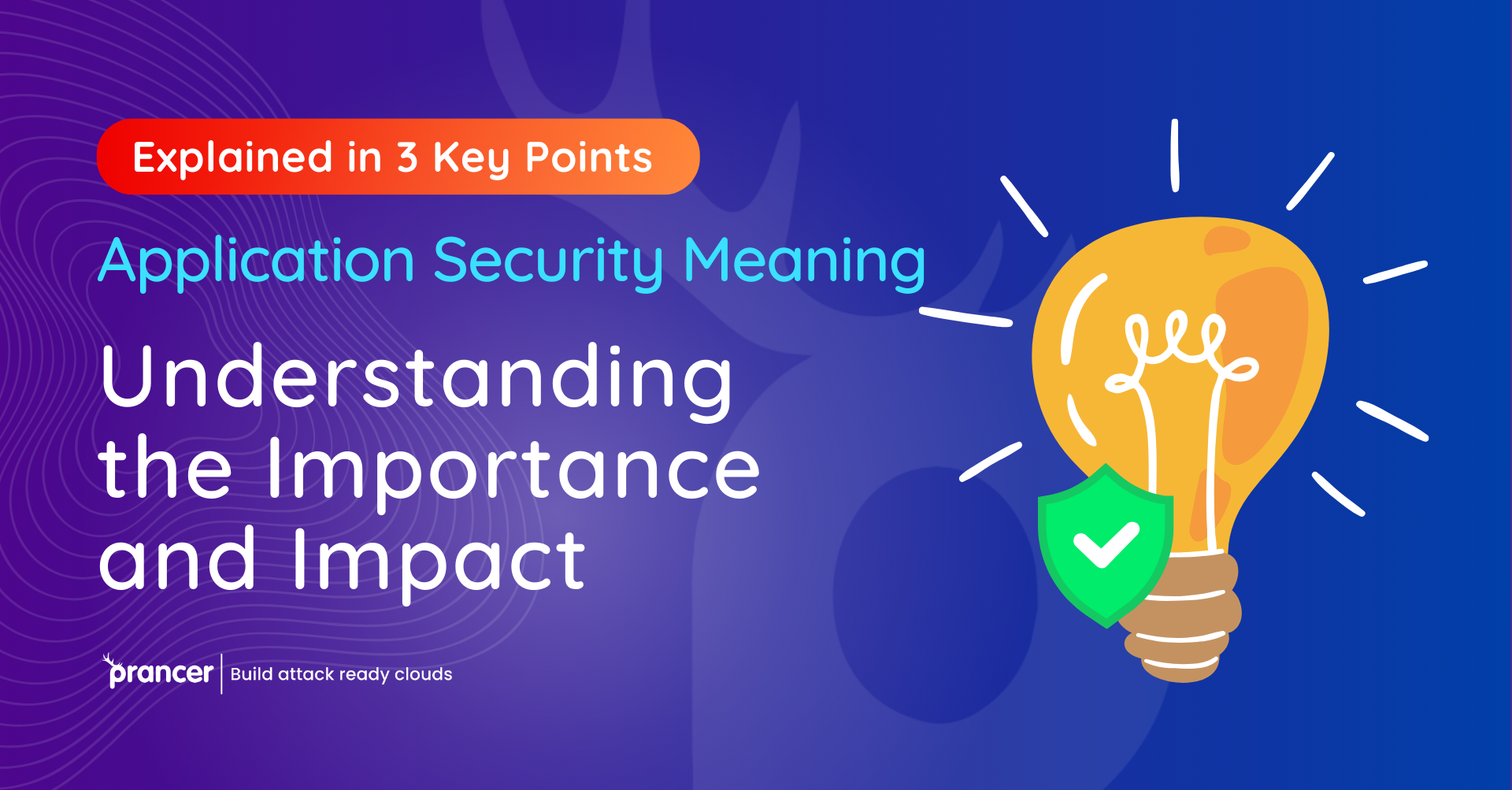

Today, it is more important than ever to comprehend what is meant by application security. The importance of securing software applications in today’s business environment where they are used widely by service providers. These practices, tools, and procedures that are applied in a bid to counter attacks, weaknesses, as well as other dangers, are encompassed by application security. One important part of this defensive system is automated penetration testing which firms, like Prancer, use to detect vulnerabilities and avert any possible cyber-attacks prior to occurrence. The main aim of this blog is to unravel thoroughly the notion of application security meaning and demonstrate its importance for our digital world.
One of the crucial components in organizational cybersecurity strategy is application security. Application security meaning’ encompasses a wide spectrum of processes required to secure applications. In relation to this, at Prancer we comprehend that application security involves more than just data protection as the cyber world changes.
1- Foundational Security Practices: To understand the concept of application security definition involves identifying the basic set of practices for developing and managing secure code. The practices incorporate code analysis, security testing and vulnerability scanning. Prancer uses those techniques to make sure the applications run tight and start safe.
2- Automated Penetration Testing: The meaning of application security involves the understanding and implementation process of the automated penetrating testing. Prancer’s automated testing tools help in identifying application weaknesses that adversaries could explore against. In today’s cyberspace, a proactive approach is very crucial.
3- Ongoing Monitoring and Response: It also entails continuous monitoring and response procedures for the same. The system Prancer advises for continual assessment of applications to react to immediate threats. Such a proactive approach makes sure that security is never a onetime event but rather an ongoing activity.
Application security understanding is very important in the current business environment, where software applications have become widespread. This concept encompasses various practices and tools whose purpose is to protect from cyber threats, with automated penetration testing being one of the key features. Prancer shows this with sophisticated tools that detect vulnerabilities and thwart potential cyber-attacks. Application security is rooted in fundamental surety practices, continuous monitoring and preventative attitudes towards identified threats. This blog explores these dimensions, emphasizing the persistent relevance of application security to protect digital assets.
Although the digital technology is in a very fast pace of development, we can see that understanding application security becomes crucial for many businesses and also organizations around the world. For that reason, securing the software programs no longer concern about the protection of the data but rather a total approach to ward off multiple cyber attacks. This method involves automated penetration testing, a procedure followed by the advanced companies such as Prancer in identifying vulnerabilities before they would become subject to any cyber-attack. This complete analysis attempts to unravel the mysteries of application security and also reveal how automated penetration testing is a very critical asset when protecting our digital world.
Evolving Landscape of Application Security
Application security is a general term and under this, all the countermeasures that are employed to protect computer software applications from outside forces are included. However, the current business climate requires more high-demand applications; therefore the security attention to application goes beyond just ensuring data protection. It now encompasses several different methodologies intended to counter a number of cyber-attacks, vulnerabilities and also other forms of cyber threats.
Automated Penetration Testing: A Proactive Approach
First of all, automated penetration testing is in the forefront of this defensive strategy. However, this procedure needs specialized tools that can copy malicious cyber-attacks on applications to detect and correct the vulnerabilities prior to their use by criminal hackers. Companies like Prancer perform an automated penetration testing to ensure that the applications remain not only secure at the point of deployment but also withstand current and future cyber threats.
Security is in three main areas of this application.
Foundational Security Practices: The process of application security begins with the basic principles upon which the development and management of disciplined code is based. Security testing, code analysis and vulnerability scanning are all part of this specific classification. Such practices are very essential in creating a secure framework within which the applications can resist initial threats.
Automated Penetration Testing: At the heart of application security in today’s digital reality is the detection and automated breach testing. This proactive nature of Prancer enables the identification of vulnerabilities that can be exploited by such many attackers. In the era when cyber attacks are always mutating and never in a good way, automated testing is no longer just an ancillary feature but it’s also a prerequisite.
Ongoing Monitoring and Response: Additionally, application security involves the continuous monitoring and intervention mechanisms. Prancer recommends ongoing assessment of the IT applications being able to respond promptly to the threats. This ensures that the security is not a one-off occurrence but rather an ongoing process, and with new threats also it develops.
How does the application security play an very essential role in the modern business world?
There is a great need for application security in the today’s business environment that institutions are operating with a large number of software applications. This concept, which includes many different methods and mechanisms is very important in the process of preventing cyber attacks. In this defensive strategy, an automated penetration testing plays a very critical role. Tools that are highly advanced and are used by numerous companies, including Prancer can easily pinpoint the vulnerabilities in their early stages to prevent any pending cyber-attacks.
Various combinations of Automated Penetration Testing with the other Security measures.
To ensure the utmost efficiency of application security, automated penetration testing should be integrated with a wide range of many other safety mechanisms. It comprises periodic changes to the security protocols, employee cybersecurity training and also a layered approach that encompass different defense measures.
Issues and trends in the autonomous penetration testing
While automated penetration testing is one of the most formidable cybersecurity tools, it comes with its own many challenges. This entails monitoring the rapidly evolving cyber threats, selecting appropriate tools that can protect against different vulnerabilities and implementing these tools into the current security architecture. The evolution of artificial intelligence and machine learning in the future will aid to further develop an automated penetration tests.
Emphasizing the Imperative of Application Security:
As we currently live in the age of digitized and increasingly business driven world, application security has become one of the most important fields that is based on automated penetration testing. It is also a non-technical requirement of the organizations with respect to the cyber security. The implementation of effective application security standards including the automated Penetration testing can help businesses to protect their digital assets, maintain the trust of customers and operate in a virtual world. This research underscores the lasting significance and the need for security application in maintaining cyber resilience.
Conclusion:
Finally, the significance of application security stretches more than explaining what it entails but instead takes into consideration measures that enhance software application protection. Robust application security can be realized by implementing automated penetration testing and continuous security monitoring at Prancer. These concerns are not just technical requirements for protecting digital assets but rather business imperatives in view of the growing cyberspace menace.
